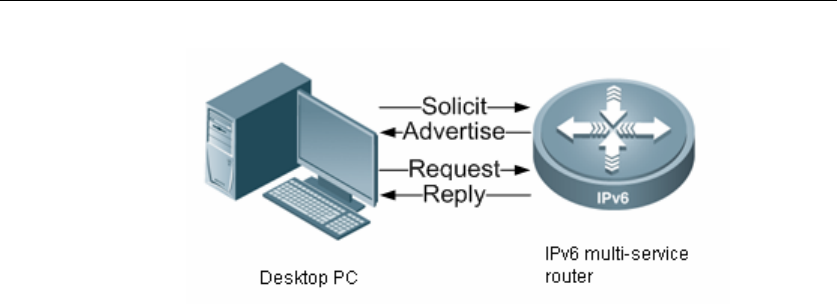
DES-7200 Configuration Guide Chapter 8 DHCPv6 Client Configuration
8-2
Fig 1 DHCPv6 stateful auto-configuration
As shown in the above figure, the new network node (host or interface) will send a
multicast message (Solicit) to all the DHCPv6 servers and DHCPv6 relays in the local
link (address: FF02::1:2; port: 547), and the DHCPv6 servers will send the unicast
Advertise reply message after receiving such message. After selecting the DHCP
server, the DHCP clients will send the Request message to solicit for configuration
information, and the DHCP server will send Reply message after completing the
allocation of parameters.
As mentioned above, such a 4-message interaction is very similar to the 4-message
interaction in DHCPv4 (Discover - Offer - Request - Reply). Certainly, DHCPv6 has
made further modifications and expansions.
Multicast is used instead of broadcast because broadcast has been abolished in
the IPv6 network.
By utilizing the option of Rapid Commit, the 4-message interaction can be
simplified into 2-message interaction (Solicit - Reply).
New DHCP message structure, DHCPv6 has made huge modifications to the
original DHCPv4 message, and has removed optional parameters in the header
of DHCP message. Only few fields to be used in all interactions are preserved.
Other optional fields are all encapsulated in the option field of the DHCP
message. During the interaction with the DHCP server and the DHCP relay, the
DHCP message sent by the DHCP client to the DHCP server will be wholly
encapsulated in the DHCP relay message as an option.
New address parameters. As mentioned above, in DHCPv6, the address field is
deleted from the fixed header of the DHCP message, and the entire address
parameters and relevant time parameters are encapsulated in an option called
IA (Identity Association). Each DHCPv6 client is associated with one IA, and
each IA can contain multiple addresses and relevant time information. The
corresponding IA can be generated in accordance with the type of address, such
as IA_NA (Identity association for non-temporary addresses) and IA_TA (Identity
association for temporary addresses).
New DHCP client/server identifier, namely DUID (DHCP Unique Identifier).


















